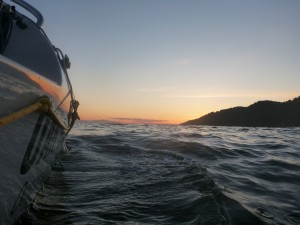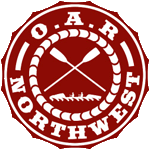
One of the reporters on the dock in Vancouver, BC ask something akin to what I was most looking forward to on this trip. I told her it would be some point, which I predicted would be after Port Hardy, where the distance from shore, or in this case normal life and civilization would ebb enough for this to feel truly like an adventure. I don’t think I was entirely sure of what that would be, but I think I have reached it. I think this point happens at different times for all of us, although I think a key ingredient for everyone was getting beyond the range of cell phone reception.
For me it came on in the unpredictable currents off of the Brooks Peninsula, unpleasant, but a part of spending enough time off shore in a rowboat. You won’t always have favorable current, so you deal as best you can when it’s bad. At the end of the day we were rewarded with whales. This type of reward seems to be available if your mentality is flexible enough. If you’re having a miserable time in nature, just relax, and I find that something extraordinary can happen that can change your whole outlook on the situation. Sometimes it is whales, sometimes it is a bit more subtle.
As we ripped along the northwest coast of Vancouver Island. Mountains ran down to the water with only a tiny visible beach before the pine trees. Except for these more temperate trees, the scene reminded me of the Hawaiian coast. Wind behind us, waves to surf and sunny blue skies blowing clouds south-at least for the present.
Rick took some extra time to sleep. He was a bit depressed after the evening in slow current. Unfortunately, he did not realize in the fog of his four morning shift he and Adams effort against the waves had gained us twelve miles past the Brooks Pen. The rest of us sat on deck and cooked. We sang while Adam played the mandolin, and we traded off rowing, navigating and talking out our next move.
When nasty winds are predicted, our crew has chosen to stop in harbors for both safety and practical reasons. When on an ocean crossing, it’s a different story. At sea, our crew deploys a sea anchor, a parachute-like device, which floats under the water’s surface and arrests the boats motion. It also keeps the bow into the waves which helps us from being breached. However, deploying such a sea anchor close to shore for hours on end and near a rocky coast would just be stupid. In our current near-coastal situation, we choose to head into Hot Springs Cove, because it is protected….and there are hot springs in which to bathe.
We made great time to the cove throughout the evening and early morning hours. An incredible sunset performed. Then a sliver of moon, the color of blood orange pulp, rose with a large and bright Venus below it. Stars appeared in the gradual fashion of day turning into night.
With a half hour left in our rowing shift I stopped to put the YSI CastAway CTD in the water, drop it about 100 feet and get a sampling profile. This way-cool science device measures water’s temperature, salinity and sound speed while it both drops through the water column and rises back through it. As I got it ready to cast the device to take a measurement, I noticed that the bioluminescence was strong.
While I was enjoying the green puddles made by the oar blade, I heard a Greg call in a tone of voice that told me to turn towards shore. Above the high dark coastal peaks that crown with stars, a large green light had shimmered into existence. Streaks of white light danced towards the heavens. Neither of us had seen this phenomenon before, but we knew exactly what it were–the northern lights. They evolved before our eyes, raising up higher and higher the streaks of white dissipated until it settled on a smooth green as if it were the lights from shinning emerald city behind the peaks “So, is why we do this?” I asked. Greg nodded.
